Conservation and Harvesting Plan for the southern Gulf of St. Lawrence spring herring fishery
Moncton, NB – April 28, 2020 – Fisheries and Oceans Canada (DFO) announced today the spring southern Gulf of St. Lawrence herring (Herring Fishing Areas 16A to G and 17) Conservation and Harvesting Plan for the 2020 season. The commercial fishery will open on April 29, 2020. Licences will be available in the National Online Licensing System (NOLS) shortly.
Given that the herring spring stock biomass remains in the critical zone according to the precautionary approach, the Total Allowable Catch (TAC) will be set at 500 t for 2020. Other than mandatory hail-in in the bait fishery for Gulf Region fish harvesters and gear marking in all fisheries, management measures announced in 2019 remain in place in 2020.
Distribution of spring quotas (metric tonnes)
| Fleet | Spring 2020 |
| Inshore fleet Areas 16A-16G | 384.4 |
| Gulf large purse seine fleet | 115.6 |
| Total | 500 |
Description
The table “Distribution of spring quota” indicate that the allocation of the Total Allowable Catch (TAC) to the inshore fleet, Herring Fishing Areas 16A to 16G will be 384.4 metric tonnes for the spring 2020 and the allocation to the Gulf large purse seine fleet will be 115.6 metric tonnes. The total TAC is 500 metric tonnes.
| Herring Fishing Area | 2020 Allocation |
| 16A | 2 |
| 16B | 18.09 |
| 16C | 84 |
| 16D | 15 |
| 16E | 115.34 |
| 16F | 5 |
| 16G | 5.72 |
| 16A-16G (June 1 - 30) | 15.64 |
| 17 (risk managed) | 5 |
| Reserve | 123.58 |
* For more details on inshore quota distribution rules, please refer to Annex 1.
Description
The table “Inshore fleet quota distribution in Herring Fishing Areas 16A to 16G and 17” describe the allocation per Herring Fishing Areas in metric tonnes. In 16A , the allocation will be 2 tonnes, 16 B, the allocation will be 18.09 tonnes, 16C, the allocation will be 84 tonnes, 16D, the allocation will be 15 tonnes, 16E, the allocation will be 115.34 tonnes, 16F, the allocation will be 5 tonnes and 16G, the allocation will be 5.72 tonnes from the opening of the fishery until May 31. The allocation from June 1 until June 30 for Herring Fishing Areas 16A to 16G is 15.64 tonnes. The allocation in Herring Fishing Area 17 will be 5 tonnes until June 30. The reserve is 123.58 tonnes.
Large Purse Seine fleet fishery on “the Edge” (4T)
This fishery, designed to target fall spawners during the month of May and June, will continue in the 2020 fishing seasons with the same parameters and management measures as in 2019. This fleet is authorized to fish their fall herring quota along the Edge in 4T during the spring season (May-June) using purse seine gear. A small fish protocol that reduces the remaining available quota according to the percentage of herring smaller than 23.5 cm (fork length) in the catch will be maintained. As in 2019, management measures will include: 20% at-sea observer coverage, 100% dockside monitoring, and mandatory vessel monitoring system to monitor this fishery. (See Annex 2 for all details).
All aid to navigation buoys may not all have been placed. Licence holders are advised to exercise extreme caution.
Furthermore, it is reminded that, during the period where fishing is authorized, it is the responsibility of the licence holder to take into account the marine safety notices issued, among others, by Environment and Climate Change Canada and Transport Canada, as well as the standards and best practices in marine safety, and to take all measures to ensure a safe fishery.
Coronavirus disease (COVID-19) - Information for industry
Canadian fisheries and aquaculture sectors provide the world with sustainably-sourced, high quality, high value, fish and seafood.
Fisheries, Oceans and the Canadian Coast Guard is committed to supporting our fisheries and aquaculture industry during these difficult times. The Government of Canada is taking the necessary steps to ensure that you can continue to operate safely and effectively and we will continue to keep you informed of the latest developments.
Visit our website to find out more.
Information
| Ben Moore Resource Management Fisheries and Oceans Canada Charlottetown, PE (902) 370-7094 |
Sandra Comeau Resource Management Fisheries and Oceans Canada Tracadie, NB (506) 395-7765 |
Alan Dwyer Resource Management Fisheries and Oceans Canada Antigonish, NS (902) 735-7114 |
| Caroline Leclerc Resource Management Fisheries and Oceans Gaspé, QC (418) 368-5559 |
Josée Richard Resource Management Fisheries and Oceans Cap-aux-Meules, QC (418) 986-2095 |
Mario Gaudet Resource Management Fisheries and Oceans Canada Moncton, NB (506) 871-0648 |
| Antoine Rivierre Resource Management Fisheries and Oceans Québec, QC (418) 640-2636 |
2020 Conservation Harvesting Plan
Spring inshore gillnet commercial fishery
- It is mandatory to hail-in the catch estimate to a dockside monitoring company every fishing trip before entering port. ALL commercial herring licence holders will need to enter in an agreement with a dockside monitoring company prior to commencing the fishery.
- As announced in December 2019, mandatory gear marking of all non-tended fixed gear fisheries will be mandatory starting in 2020 in Eastern Canada and Québec. The gear marking requirements will identify the regions and the fishery. All requirement and particulars regarding the gear marking were published in a notice to fish harvesters available here.
- A Dockside Monitoring Program (DMP) with 100% dockside monitoring will be required in all Herring Fishing Areas (HFA) except 16A, 16B (Québec and certain ports in northern New Brunswick) and 16D, where a Catch Monitoring Program (CMP) with 100% radio hail and a minimum of 25% monitoring at dockside, as well as logbook will be in place. The dockside monitoring companies will have to provide, on a daily basis to DFO, the amount of herring landed/hailed per fish harvester.
- In addition, a logbook will be mandatory for any herring landed in the Québec Region by Gulf Region licence holders. Fish harvesters landing in the Québec Region must acquire a logbook (FC-EP-01 or FC-EP-02) from one of the suppliers listed here.
- The use of an electronic logbook (Elog) is mandatory for licence holders from the Québec Region. Fish harvesters must use a client application approved by Fisheries and Oceans Canada for the Quebec region for the form ELOG - Logbook – Gillnets. Furthermore, fish harvesters must have obtained and installed their Elog Key in their client application in order to allow data transmission to the Department. The Elog must be completed for each fishing expedition and “closed” before arriving at port/landing. A fishing expedition starts when a fishing vessel leaves a port to engage in fishing and ends when fish caught during that period is offloaded. Hence, when a fisher goes back to port for a reason other than for offloading fish and leaves port again, the fishing expedition goes on until fish are offloaded. To consult the list of client applications approved by the Department and to obtain you Elog key, visit Fisheries and Oceans Canada web page. To request a modification to data that has been transmitted to Fisheries and Oceans Canada, you must communicate with the client support service at 1-877-535-7307.
- Weekly landing limits of 10,206 kg will be implemented in all HFAs except 16A, 16D and 16F, where no restrictions will apply.
- Spawning areas will be closed in all HFAs except 16A and 16F (Charts 1 to 6).
- No nets or herring will be allowed to be on board during a fishing trip between 18:00 and 04:00 (ADT) every day (due to safety considerations), in HFA 16C, 16E, 16F and 16G. In 16B, the same restrictions apply every day between 22:00 and 03:00 (ADT).
- Landings are counted against the quota in the area where the fish is landed when the said area is open. Landings are counted against the quota in the adjacent area when the fish is landed in a closed area.
- Other management measures for all HFA’s are outlined in Table 1.
Bait fishery
- As announced in the April 2, 2020, Notice to Fish Harvesters, licence holders from the Gulf region are now required to hail-in to a dockside monitoring company to report their bait catch estimate every fishing trip before entering port. ALL herring/mackerel licence holders will need to enter in an agreement with a dockside monitoring company prior to commencing the fishery. As detailed in the conditions of licence, herring/mackerel bait licence holders will still be required to:
- MAINTAIN a Bait Fishery Monitoring Document,
- HAIL-IN the catch estimates to a dockside monitoring company; and
- SEND the report of these catches to their dockside monitoring company.
- The use of an electronic logbook (Elog) is mandatory for licence holders from the Québec Region to declare the catch estimates after every fishing trip before entering port.
- With a bait licence, a fish harvester may only fish up to three gillnets to a maximum length of 50 fathoms of gillnets provided that the catch is used solely for personal bait use.
- The minimum mesh size will be 57.1 mm from January 1 to June 30 and 66.7 mm from July 1 to December 31. In 2020, the maximum quantity of herring or mackerel or the combination of both species a fish harvester is permitted to catch and retain is 907 kg per fishing trip.
- While fishing under the authority of a commercial herring, mackerel or gaspereau licence, bait licences are not valid. Furthermore, a fish harvester cannot fish under the authority of a bait licence in the same calendar day that they have landed herring, mackerel or gaspereau under the authority of a commercial licence. It is strictly forbidden to sell any species of fish caught under the authority of a bait licence.
Table 1
| Summary of the spring inshore management measures by HFA - 2020 | ||||||
| Fishing Area | Dockside Monitoring Program (DMP) or Catch Monitoring Program (CMP) | Allocation (t) | Period | Net (mesh size / depth / length) | Weekend Closures | Trip Limit |
| 16A – Île Verte | CMP - declaration of 100% of catches through the radio and dockside monitoring of 25% of landings | 2 | April 29 to May 31 | 57.1mm min / 100 meshes / 375 fath. | None | No limit |
| 16B – Baie des Chaleurs (fixed gear) Small purse Seiners |
DMP (in NB) – Declaration of 100% of catches to dockside monitoring companies and 100% of DMP except in certain northern NB ports where it is declaration of 100% of catches to dockside monitoring companies and DMP on 25% of landings. CMP in Québec - declaration of 100% of catches through the radio and dockside monitoring for 25% of landings |
18.09 | April 29 to May 31 | 57.1mm min / 100 meshes / 300 fath. | None | Weekly limit of 10,206 kg (22,250 lb) |
| Up to 22.75% (4.3 t) of 16B spring allocation | April 29 to May 31 | N/A | None | Weekly limit of 10,206 kg (22,250 lbs) | ||
| 16 C– Escuminac | Declaration of 100% of catches and 100% DMP | 84 | April 29 to May 31 | 57.1mm min / 125 meshes / 343 fath. | 12:00 (noon) Friday to 12:00 (noon) Saturday | Weekly limit of 10,206 kg (22,250 lb) |
| 16D – Magdalen Islands | CMP - declaration of 100% of catches through the radio and dockside verification for 25% of landings | 15 | April 29 to May 31 | 57.1mm min / 125 meshes / 200 fath. | None | No limit |
| 16E – Western PEI, south-eastern NB and northern GNS | Declaration of 100% of catches and 100% of DMP | 115.34 | April 29 to May 31 | 57.1mm min / 125 meshes / 343 fath. | None | Weekly limit of 10,206 kg (22,250 lbs) |
| 16F – Pictou | Declaration of 100% of catches and 100% of DMP | 5 | April 29 to May 31 | 57.1mm min / 150 meshes / 180 fath. | 12:00 (noon) Sunday to 12:00 (noon) Monday | No limit |
| 16G – Fishermen’s Bank | Declaration of 100% of catches and 100% of DMP | 5.72 | April 29 to May 31 | 57.1mm min / 100 meshes / 343 fath. | 12:00 (noon) Friday to 12:00 (noon) Saturday | Weekly limit of 10,206 kg (22,250 lbs) |
| 16A-G | As per individual areas (above) | 15.64 | June 1 - June 30 | As per individual areas (above) | None | As per individual areas (above) |
| Bait | Declaration of 100% of catches and sending Bait Fishery Monitoring Document to dockside monitoring company | April 1 to Dec 31 | 57.1 mm April 1-June 30 66.7 mm July 1 – Dec 31 50 fathoms total | No bait fishing on same day as commerc. fishing | 907 kg per fishing trip | |
Description
The description of the “Summary of the spring inshore management measures by Herring Fishing Areas for 2020 is as follows:
In 16A, there is a mandatory declaration of all catches by radio and dockside monitoring of 25% of landings. The allocation is 2 tonnes. The period of fishing is April 29 until May 31. The minimum mesh size is 57.1 mm, the net must be a maximum of 100 meshes deep and no longer than 375 fathoms long.
In 16B, in New-Brunswick there a mandatory declaration of all catches to dockside monitoring companies and 100% dockside monitoring of landings except in certain northern New-Brunswick ports where there is a mandatory declaration of all catches and dockside monitoring of 25% of landings. In Québec, there is a mandatory declaration of all catches by radio and dockside monitoring of 25% of landings. The allocation is 18.09 tonnes but up to 22.75% of this allocation, representing 4.3 tonnes, is allocated to the small purse seiners. The period of fishing is April 29 until May 31. The minimum mesh size is 57.1 mm, the net must be a maximum 100 meshes deep and no longer than 300 fathoms long. The weekly landing limit is 10,206 kilogrammes.
In 16C, there a mandatory declaration of all catches to dockside monitoring companies and 100% dockside monitoring of landings. The allocation is 84 tonnes. The period of fishing is April 29 until May 31. The minimum mesh size is 57.1 mm, the net must be a maximum of 125 meshes deep and no longer than 343 fathoms long. There is a weekend closure every week until May 31 starting at noon on Friday and ending at noon on Saturday. The weekly landing limit is 10,206 kilogrammes.
In 16D, there is a mandatory declaration of all catches by radio and dockside monitoring of 25% of landings. The allocation is 15 tonnes. The period of fishing is April 29 until May 31. The minimum mesh size is 57.1 mm, the net must be a maximum of 125 meshes deep and no longer than 200 fathoms long.
16E, there a mandatory declaration of all catches to dockside monitoring companies and 100% dockside monitoring of landings. The allocation is 115.34 tonnes. The period of fishing is April 29 until May 31. The minimum mesh size is 57.1 mm, the net must be a maximum of 125 meshes deep and no longer than 343 fathoms long. The weekly landing limit is 10,206 kilogrammes.
16F, there a mandatory declaration of all catches to dockside monitoring companies and 100% dockside monitoring of landings. The allocation is 5 tonnes. The period of fishing is April 29 until May 31. The minimum mesh size is 57.1 mm, the net must be a maximum of 150 meshes deep and no longer than 180 fathoms long. There is a weekend closure every week until May 31 starting at noon on Sunday and ending at noon on Monday.
16G, there a mandatory declaration of all catches to dockside monitoring companies and 100% dockside monitoring of landings. The allocation is 5.72 tonnes. The period of fishing is April 29 until May 31. The minimum mesh size is 57.1 mm, the net must be a maximum of 100 meshes deep and no longer than 343 fathoms long. There is a week closure every weekend until May 31 starting at noon on Friday and ending at noon on Saturday. The weekly landing limit is 10,206 kilogrammes.
Between June 1 and June 30 in Herring Fishing Areas 16A to 16G, the dockside monitoring program or the catch monitoring program is as described above for each herring fishing areas. The allocation is 15.64 tonnes. The mesh size, depth and length of the gear is as per the individual herring fishing areas as described above. The is no weekend closures and the weekly limits are as described above for each herring fishing areas.
Bait fishery, there a mandatory declaration of all catches to dockside monitoring companies and sending the Bait Fishery Monitoring Document to the dockside monitoring company. The season if from April 1 until December 31. The minimum mesh size from April 1 until June 30 is 57.1 mm and from July 1 until December 31, it is 66.7 mm. The total length allowed is 50 fathoms. There is no bait fishing on the same day as commercial fishing. The maximum daily landing allowed is 907 kilogrammes.
CHART 1
Closure of the commercial inshore herring fishery off northeast PEI (April 1 to June 30) and of the large purse seiners herring fishery (year round)
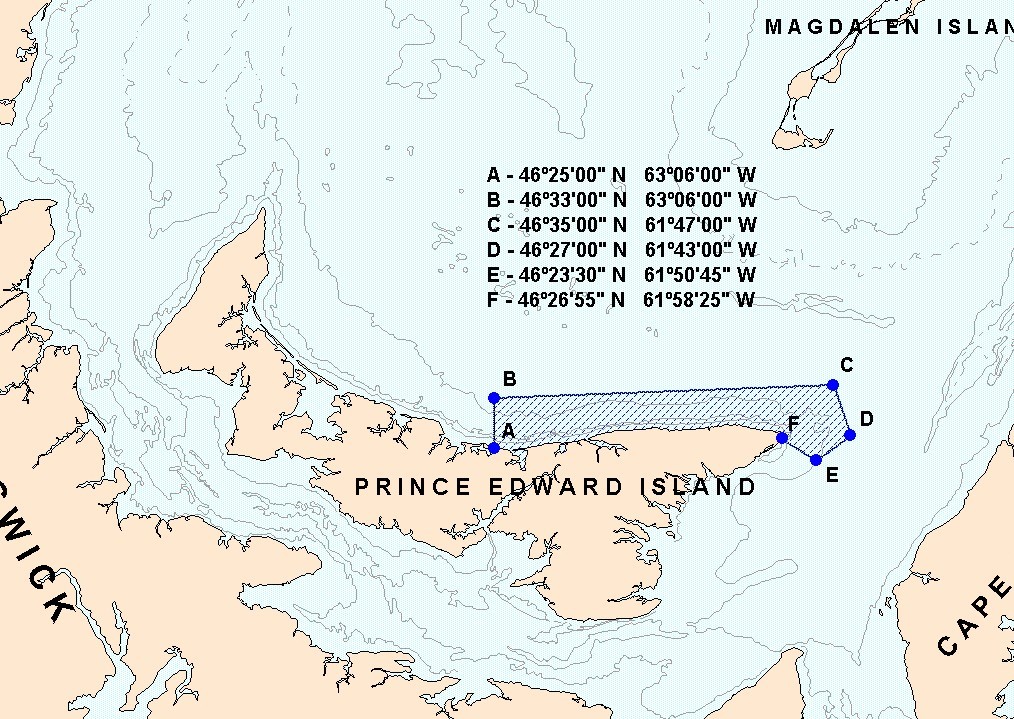
Note: These reference points are based on the geodesic system North American Datum 1927 (NAD27)
Description
The closure of the commercial inshore herring fishing northeast of Prince Edward Island from April 1 to June 30 and of the large purse seine fishery year round is defined as the waters enclosed by the coastlines and rhumb lines (similar to straight lines plotted on a nautical chart) joining the following point s in the order they are listed:
Point A 46°25’00’’ longitude North and 63°06’00’’ latitude West
Point B 46°33’00’’ longitude North and 63°06’00’’ latitude West
Point C 46°35’00’’ longitude North and 61°47’00’’ latitude West
Point D 46°27’00’’ longitude North and 61°43’00’’ latitude West3
Point E 46°23’30’’ longitude North and 61°50’45’’ latitude West
Point F 46°26’55’’ longitude North and 61°58’25’’ latitude West
Note: These reference points are based on the geodesic system North American Datum 1927 (NAD27)
CHART 2
Closure of the commercial spring fishery in a portion of HFA 16E near Cape Egmont
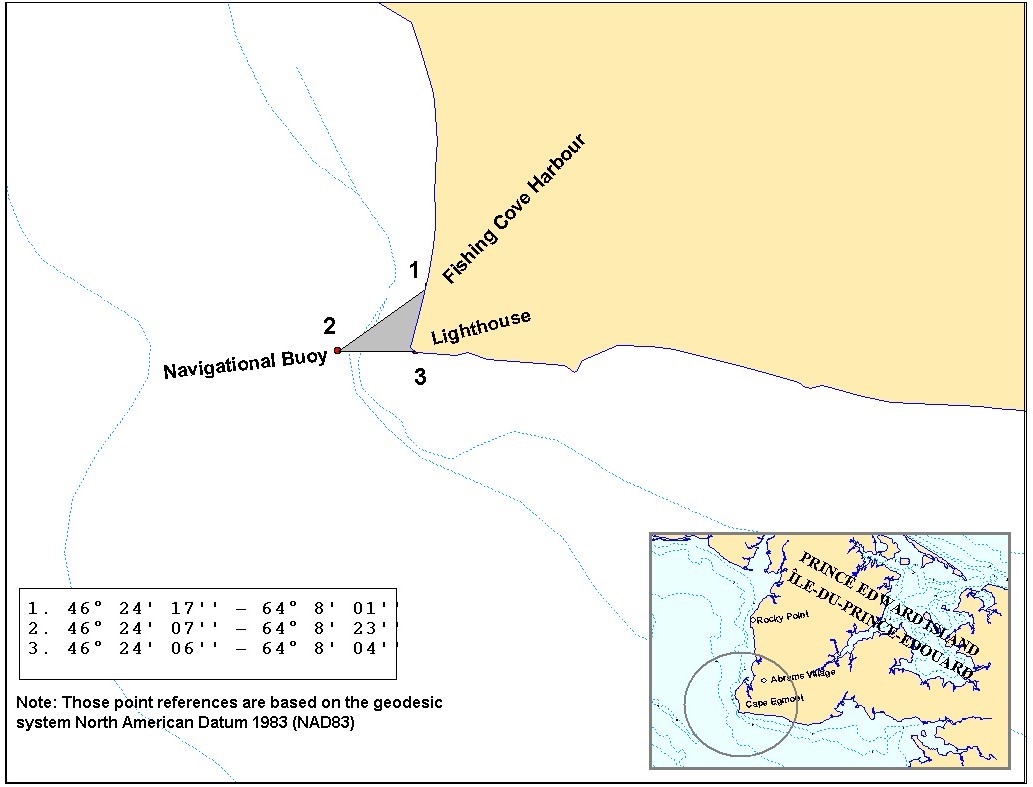
Description
The closure of the spawning ground near Cape Egmont on Prince Edward Island in Herring Fishing Area 16E is defined as the waters enclosed by the coastlines and rhumb lines (similar to straight lines plotted on a nautical chart) joining the following point s in the order they are listed:
Point 1 46°24’17’’ latitude North and 64°08’01’’ longitude West
Point 2 46°24’07’’ latitude North and 64°08’23’’ longitude West
Point 3 46°24’06’’ latitude North and 64°08’04’’ longitude West
Note: These reference points are based on the geodesic system North American Datum 1983 (NAD83)
CHART 3
Exclusion zone in the Grande-Entrée Channel in HFA 16D
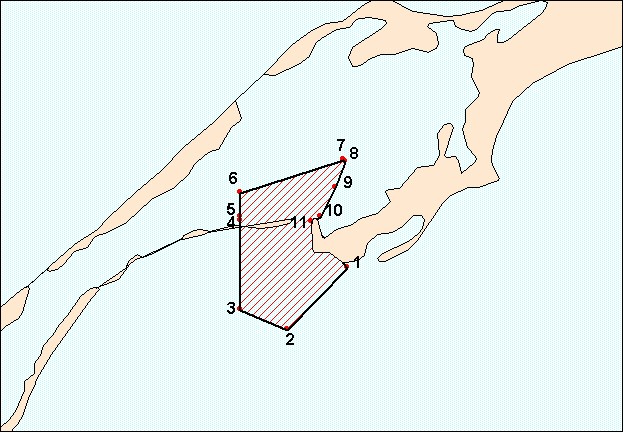
| 1. 47° 32' 30'' N - 61° 32' 39'' W | 7. 47° 34' 39'' N - 61° 32' 46'' W |
| 2. 47° 31' 16'' N - 61° 34' 26'' W | 8. 47° 34' 37'' N - 61° 32' 43'' W |
| 3. 47° 31' 40'' N - 61° 35' 48'' W | 9. 47° 34' 06'' N - 61° 33' 00'' W |
| 4. 47° 33' 26'' N - 61° 35' 48'' W | 10. 47° 33' 31'' N - 61° 33' 27'' W |
| 5. 47° 33' 31'' N - 61° 35' 48'' W | 11. 47° 33' 25'' N - 61° 33' 43'' W |
| 6. 47° 34' 00'' N - 61° 35' 48'' W |
Description
The closure of the exclusion zone in the Grande-Entrée channel in the Magdalen Islands in Herring Fishing Area 16D is defined as the waters enclosed by the coastlines and rhumb lines (similar to straight lines plotted on a nautical chart) joining the following point s in the order they are listed:
Point 1 47° 32' 30'' longitude North and 61° 32' 39'' latitude West
Point 2 47° 31' 16'' longitude North and 61° 34' 26'' latitude West
Point 3 47° 31' 40'' longitude North and 61° 35' 48'' latitude West
Point 4 47° 33' 26'' longitude North and 61° 35' 48'' latitude West
Point 5 47° 33' 31'' longitude North and 61° 35' 48'' latitude West
Point 6 47° 34' 00'' longitude North and 61° 35' 48'' latitude West
Point 7 47° 34' 39'' longitude North and 61° 32' 46'' latitude West
Point 8 47° 34' 37'' longitude North and 61° 32' 43'' latitude West
Point 9 47° 34' 06'' longitude North and 61° 33' 00'' latitude West
Point 10 47° 33' 31'' longitude North and 61° 33' 27'' latitude West
Point 11 47° 33' 25'' longitude North and 61° 33' 43'' latitude West
Exclusion zone in the Havre Aubert harbour in HFA 16D
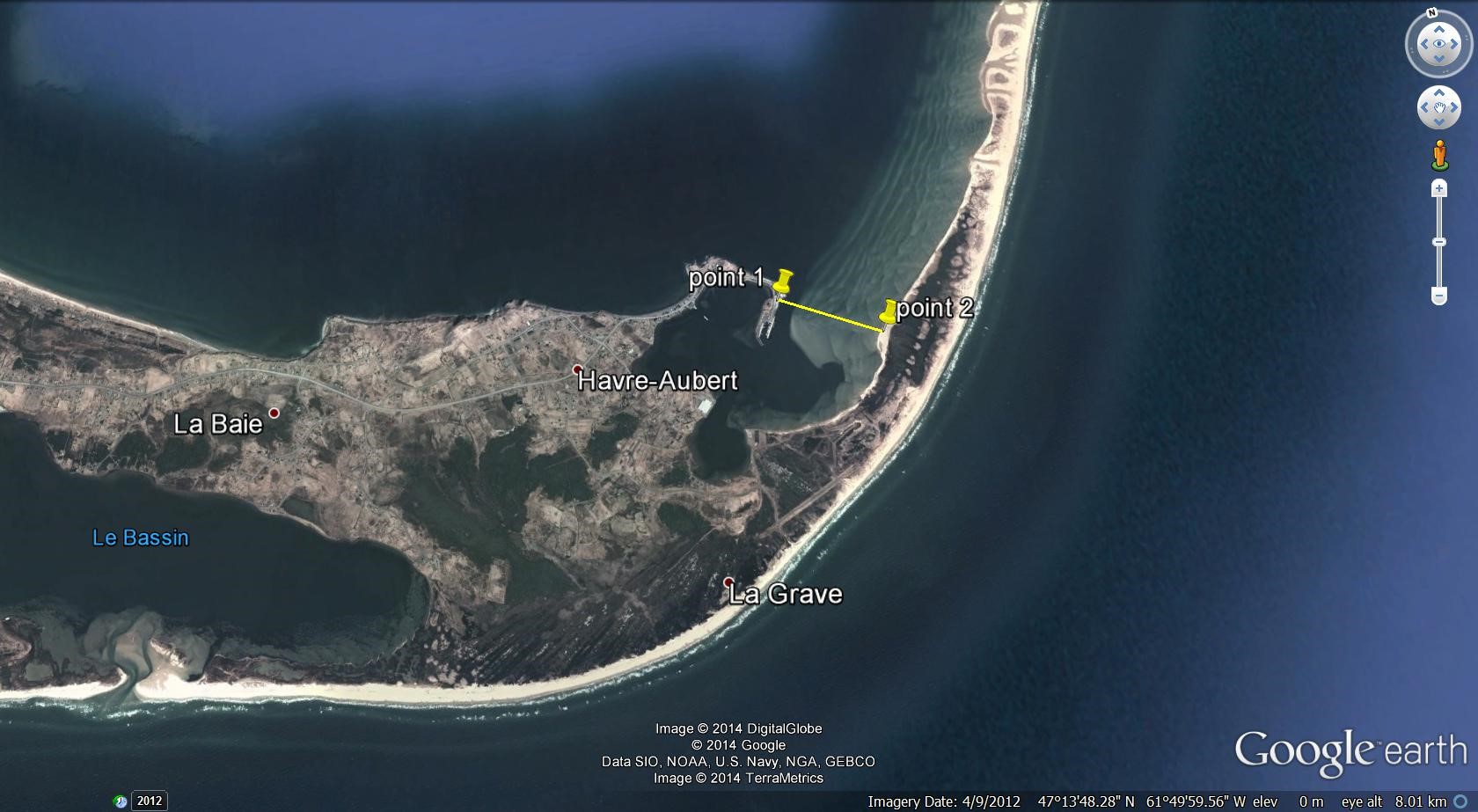
| 1. 47° 14' 09.20'' N - 61° 49' 40.10'' W | 2. 47° 13' 57.30'' N - 61° 49' 09.90'' W |
Note: These reference points are based on the geodesic system North American Datum 1983 (NAD83)
Description
The closure of the exclusion zone in the Grande-Entrée channel in the Magdalen Islands in Herring Fishing Area 16D is defined as the waters enclosed by the coastlines and rhumb lines (similar to straight lines plotted on a nautical chart) joining the following point s in the order they are listed:
Point 1 47° 14' 09.20'' longitude North and 61° 49' 40.10'' latitude West
Point 2 47° 13' 57.30'' longitude North and 61° 49' 09.90'' latitude West
Note: These reference points are based on the geodesic system North American Datum 1983 (NAD83)
CHART 4
Closure of the spring commercial fishery on spawning beds in New Mills, Carleton and
St-Omer in HFA 16B (Grey zones)
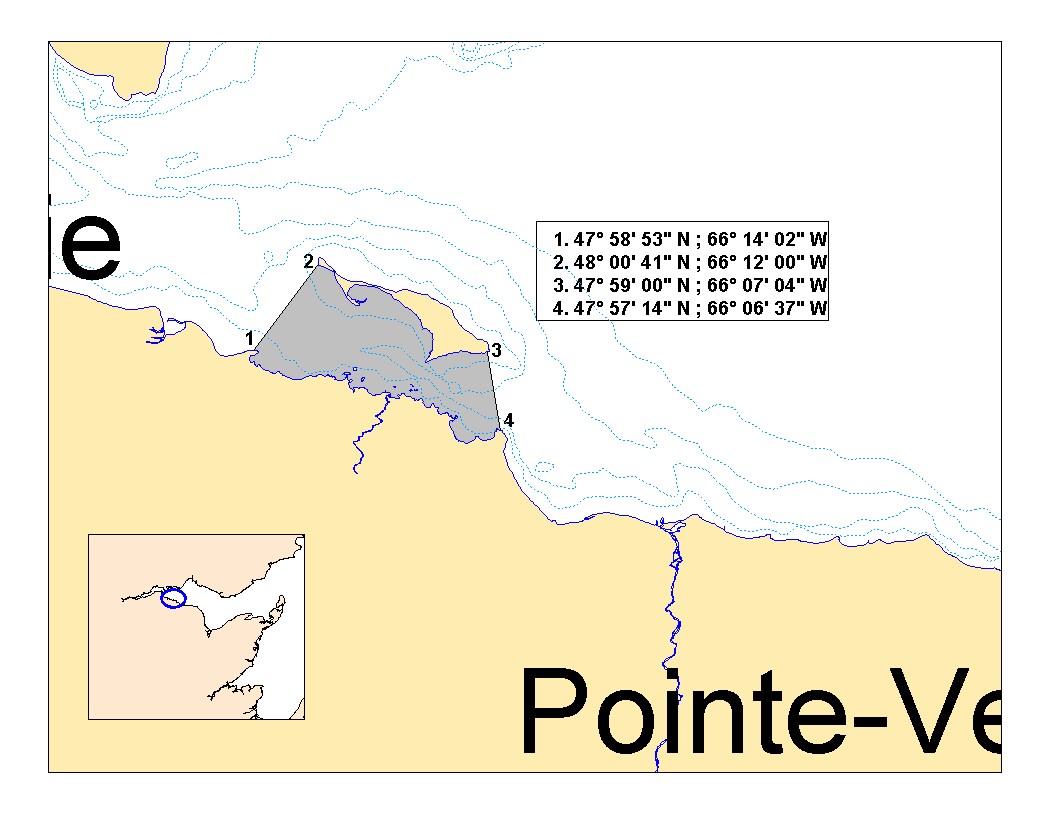
Description
The closure of spawning beds near New Mills in New Brunswick in Herring Fishing Area 16B is defined as the waters enclosed by the coastlines and rhumb lines (similar to straight lines plotted on a nautical chart) joining the following point s in the order they are listed:
Point 1 47°58’53’’ longitude North and 66°14’ 2’’ latitude West
Point 2 48°00’41’’ longitude North and 66°12’00’’ latitude West
Point 3 47°59’00’’ longitude North and 66°07’04’’ latitude West
Point 4 47°57’14’’ longitude North and 66°06’34’’ latitude West
Note: These reference points are based on the geodesic system North American Datum 1983 (NAD83)
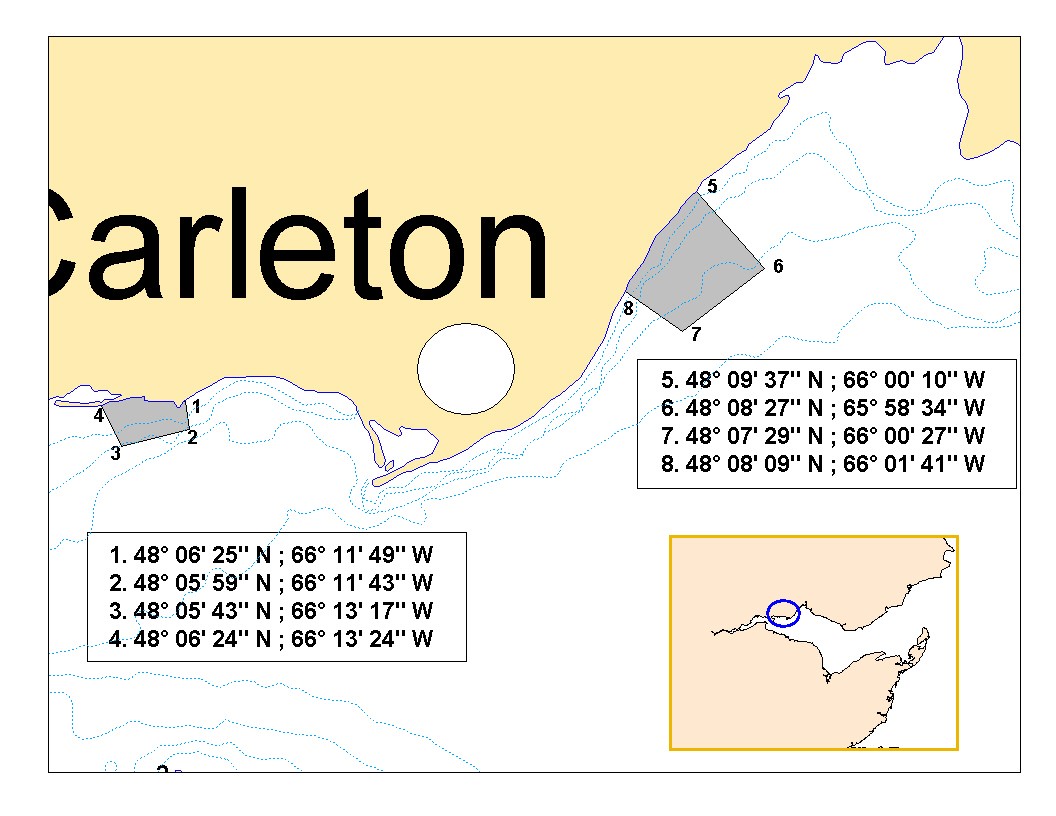
Note: These reference points are based on the geodesic system North American Datum 1983 (NAD83)
Description
The closure of the spawning beds near Carleton on the Gaspesian Peninsula in Herring Fishing Area 16B is defined as the waters enclosed by the coastlines and rhumb lines (similar to straight lines plotted on a nautical chart) joining the following point s in the order they are listed:
Point 1 48°06’25’’ longitude North and 66°11’49’’ latitude West
Point 2 48°05’59’’ longitude North and 66°11’43’’ latitude West
Point 3 48°05’43’’ longitude North and 66°13’14’’ latitude West
Point 4 48°06’24’’ longitude North and 66°13’24’’ latitude West
The closure of the spawning beds near St. Omer on the Gaspesian Peninsula in Herring Fishing Area 16B is defined as the waters enclosed by the coastlines and rhumb lines (similar to straight lines plotted on a nautical chart) joining the following point s in the order they are listed:
Point 1 48°09’37’’ longitude North and 66°00’10’’ latitude West
Point 2 48°08’27’’ longitude North and 66°58’34’’ latitude West
Point 3 48°07’29’’ longitude North and 66°00’27’’ latitude West
Point 4 48°08’09’’ longitude North and 66°01’41’’ latitude West
Note: These reference points are based on the geodesic system North American Datum 1983 (NAD83)
CHART 5
Closure of the spring commercial fishery on a spawning bed near Point Escuminac (N.B.) in HFA 16C (Grey zone)
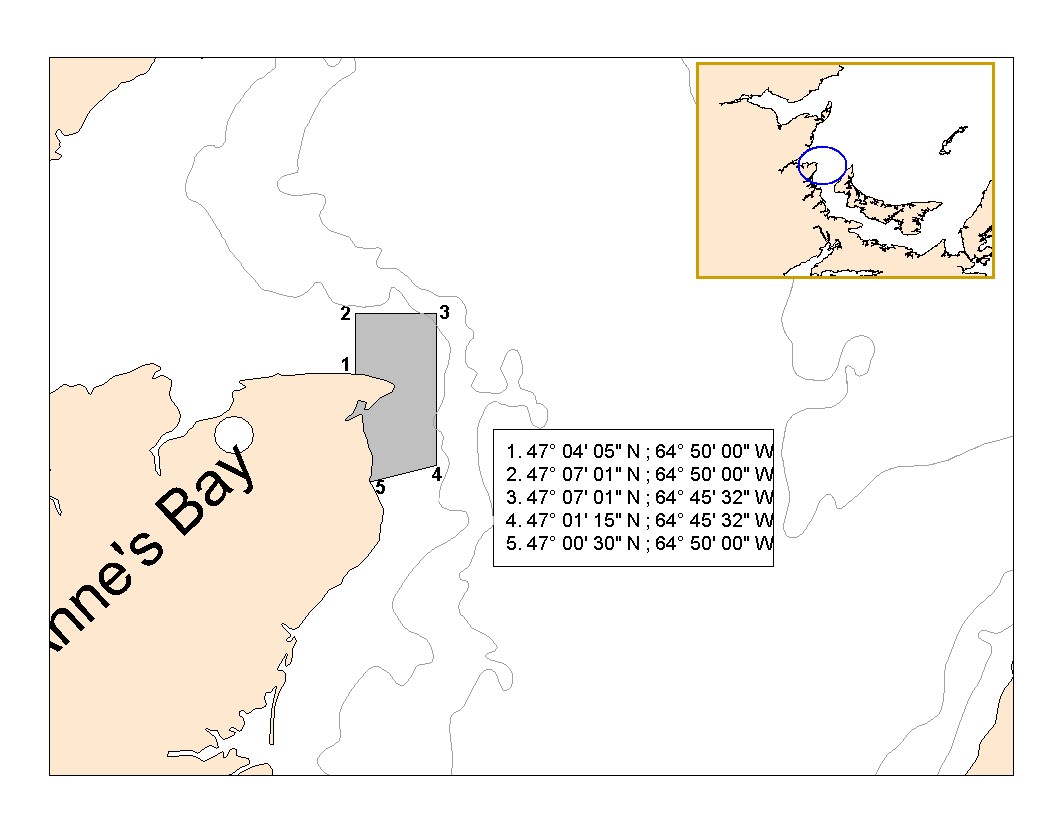
Note: These reference points are based on the geodesic system North American Datum 1983 (NAD83)
Description
The closure of the spawning bed near Point Escuminac in New Brunswick in Herring Fishing Area 16C is defined as the waters enclosed by the coastlines and rhumb lines (similar to straight lines plotted on a nautical chart) joining the following point s in the order they are listed:
Point 1 47°04’05’’ longitude North and 64°50’00’’ latitude West
Point 2 47°07’01’’ longitude North and 64°50’00’’ latitude West
Point 3 47°07’01’’ longitude North and 64°45’32’’ latitude West
Point 4 47°01’15’’ longitude North and 64°45’32’’ latitude West
Point 5 47°00’30’’ longitude North and 64°50’00’’ latitude West
Note: These reference points are based on the geodesic system North American Datum 1983 (NAD83)
CHART 6
Closure of the spring commercial fishery on a spawning bed near Cape Jourimain (N.B.) in HFA 16E (Grey zone)

Note: These reference points are based on the geodesic system North American Datum 1983 (NAD83)
Description
The closure of the spawning bed near Cape Jourimain in New Brunswick in Herring Fishing Area 16E is defined as the waters enclosed by the coastlines and rhumb lines (similar to straight lines plotted on a nautical chart) joining the following point s in the order they are listed:
Point 1 46°09’20’’ longitude North and 63°52’53’’ latitude West
Point 2 46°10’23’’ longitude North and 63°52’53’’ latitude West
Point 3 46°10’23’’ longitude North and 63°51’33’’ latitude West
Point 4 46°09’13’’ longitude North and 63°51’33’’ latitude West
Note: These reference points are based on the geodesic system North American Datum 1983 (NAD83)
Annex 1
Spring Herring Reserve Distribution Rules for the 2020 Sharing Plan
- Each HFA will maintain its existing quota share at the end of the sharing plan.
- Establishment of a 123.56 t reserve taken by removing 100 t from the top of the total inshore quota before distribution to HFAs according to actual shares and by removing 0.93 t of the HFA 16A, 8.7 t of the HFA 16C, 12.13 t of the HFA 16D and 1.8 t of the HFA 16F allocations (Bringing those HFA’s to their 2007 catch level). No allocation was removed from HFA 16G because it’s allocation after deduction 100 t from the top of the total inshore quota was less than it’s 2007 catch level.
- All HFAs will have access to the reserve when their initial allocation has been caught before June 1.
- On June 1, uncaught area allocations and remaining reserve are transferred to the June 1-30 quota. Starting on June 1, any fisher may fish against the HFA 16A-G, June 1-30 quota.
- The spring inshore fishery will be closed if the total inshore quota is caught.
Spring - Share scenario based on establishement of a reserve
(2020 Reference fixed gear quota = 384.4 t) TAC 500 t
| HFA | Current Share | Allocation based on current shares (Column A) |
Allocation after deducting 100 t | Allocation after deduction from HFA 16A, C, D, F, G & Initial allocation |
Rules for accessing the reserve (123.56 t) |
| 16A | 1.03% | 3.96 | 2.93 | 2 | Total catches prior to May 31 no higher than current shares (column A - 3.96 t) |
| 16B | 6.36% | 24.45 | 18.09 | 18.09 | 25 t increments up to a total of 68.09 t |
| 16C | 32.60% | 125.31 | 92.71 | 84 | 25 t increments to the level of current shares (column A - 125.31 t) |
| 16D | 9.54% | 36.67 | 27.13 | 15 | 25 t increments to the level of current shares (column A - 36.67 t) |
| 16E | 40.56% | 155.91 | 115.34 | 115.34 | 25 t increments to a total of 165.34 t |
| 16F | 2.39% | 9.19 | 6.80 | 5 | Total catches prior to May 31 no higher than current shares (column A - 9.19 t) |
| 16G | 2.01% | 7.73 | 5.72 | 5.72 | Total catches prior to May 31 no higher than current shares (column A - 7.73 t) |
| 16A-G (June 1-30) |
5.50% | 21.14 | 15.64 | 15.64 | 100% of remaining reserve and unused area allocations after June 1 |
| 17 | 5 | 5 | 5 | ||
| Total | 100% | 384.36 | 284.36 | 260.79 |
Description
The “Share scenario based on the establishment of a reserve – Spring” is based on a fixed gear quota of 384.4 tonnes out of a total allowable catch of 500 tonnes.
In 16A, the current share is 1.03%, the allocation based on current shares (column A) is 3.96 tonnes. The allocation after deducting 100 tonnes is 2.93 tonnes. The allocation after deduction from herring fishing areas 16A, 16C, 16D, 16F and 16G, and also the initial allocation is 2 tonnes. The rules for accessing the reserve of 123.56 tonnes is: the total catches prior to May 31 cannot be higher than the current shares in column A which is 3.96 tonnes.
In 16B, the current share is 6.36%, the allocation based on current shares (column A) is 24.45 tonnes. The allocation after deducting 100 tonnes is 18.09 tonnes. The allocation after deduction from herring fishing areas 16A, 16C, 16D, 16F and 16G, and also the initial allocation is 18.09 tonnes. The rules for accessing the reserve of 123.56 tonnes is: able to receive from the reserve in increments of 25 t up to a total of 68.09 tonnes.
16C, the current share is 32.6%, the allocation based on current shares (column A) is 125.31 tonnes. The allocation after deducting 100 tonnes is 92.71 tonnes. The allocation after deduction from herring fishing areas 16A, 16C, 16D, 16F and 16G, and also the initial allocation is 84 tonnes. The rules for accessing the reserve of 123.56 tonnes is: able to receive from the reserve in increments of 25 t up to the level of current shares which is 125.31 tonnes.
16D, the current share is 9.54%, the allocation based on current shares (column A) is 36.67 tonnes. The allocation after deducting 100 tonnes is 27.13 tonnes. The allocation after deduction from herring fishing areas 16A, 16C, 16D, 16F and 16G, and also the initial allocation is 15 tonnes. The rules for accessing the reserve of 123.56 tonnes is: able to receive from the reserve in increments of 25 t up to the level of current shares which is 36.67 tonnes.
16E, the current share is 40.56%, the allocation based on current shares (column A) is 155.91 tonnes. The allocation after deducting 100 tonnes is 115.34 tonnes. The allocation after deduction from herring fishing areas 16A, 16C, 16D, 16F and 16G, and also the initial allocation is 115.34 tonnes. The rules for accessing the reserve of 123.56 tonnes is: able to receive from the reserve in increments of 25 t up to a total of 165.34 tonnes.
In 16F, the current share is 2.39%, the allocation based on current shares (column A) is 9.19 tonnes. The allocation after deducting 100 tonnes is 6.8 tonnes. The allocation after deduction from herring fishing areas 16A, 16C, 16D, 16F and 16G, and also the initial allocation is 5 tonnes. The rules for accessing the reserve of 123.56 tonnes is: the total catches prior to May 31 cannot be higher than the current shares in column A which is 9.19 tonnes.
In 16G, the current share is 2.01%, the allocation based on current shares (column A) is 7.73 tonnes. The allocation after deducting 100 tonnes is 5.72 tonnes. The allocation after deduction from herring fishing areas 16A, 16C, 16D, 16F and 16G, and also the initial allocation is 5.72 tonnes. The rules for accessing the reserve of 123.56 tonnes is: the total catches prior to May 31 cannot be higher than the current shares in column A which is 7.73 tonnes.
In 16A to 16G between June 1 and June 30, the current share is 5.5% and the allocation based on current shares is 21.14 tonnes. The allocation after deducting 100 tonnes is 15.64 tonnes. The allocation after deduction from herring fishing areas 16A, 16C, 16D, 16F and 16G, and also the initial allocation is 15.64 tonnes. The remaining reserve and unused area allocations will be transferred to June fishing time.
In Area 17, the allocation is 5 tonnes.
Annex 2
Large Purse Seine Fleet Fishery on “the Edge” (4T)
- All Gulf large purse seine licence holders are authorized to conduct fishing activities in the spring on the Edge of 4T (Chart 7). This herring fishery targets fall origins spawners
- The large purse seine fleet is authorized to fish their fall herring quota along the Edge in 4T during the spring season (May-June). Catches will be counted towards this quota.
- All vessels must be equipped with an operational Vessel Monitoring System during fishing activities.
- There will be 20% observer coverage at sea during the spring fishery along the Laurentian channel (“Edge fishery”). A Fisheries Management Order was issued on April 2, 2020 authorizing fishing activities to be carried out without any at-sea observer onboard for a period of 45 days. See the text of the order below.
- The maximum authorized by-catch of mackerel and capelin is set at 10% each of the directed species. The maximum authorized by-catch of groundfish is set at 5% of the directed species. Monitoring and sampling for by-catch species will be conducted at sea and the by-catch may be verified at dockside by fishery officers.
- A small fish protocol is in place to control the capture of juvenile herring during the purse seine fishery with a 100% dockside monitoring. The small fish protocol reduces the remaining available quota according to the percentage of herring smaller than 23.5 cm (fork length) in the catch.
- A scientific protocol has been developed to verify the spawning component of the herring caught. The proportion of spring and fall spawners in the catch will be determined by DFO. If at any time the amount of spring spawners in the catch reaches the spring allocation, the purse seine fishery will be closed until July 1.
CHART 7
Area where the large purse seine fleet « Edge » fishery will occur (area in blue).
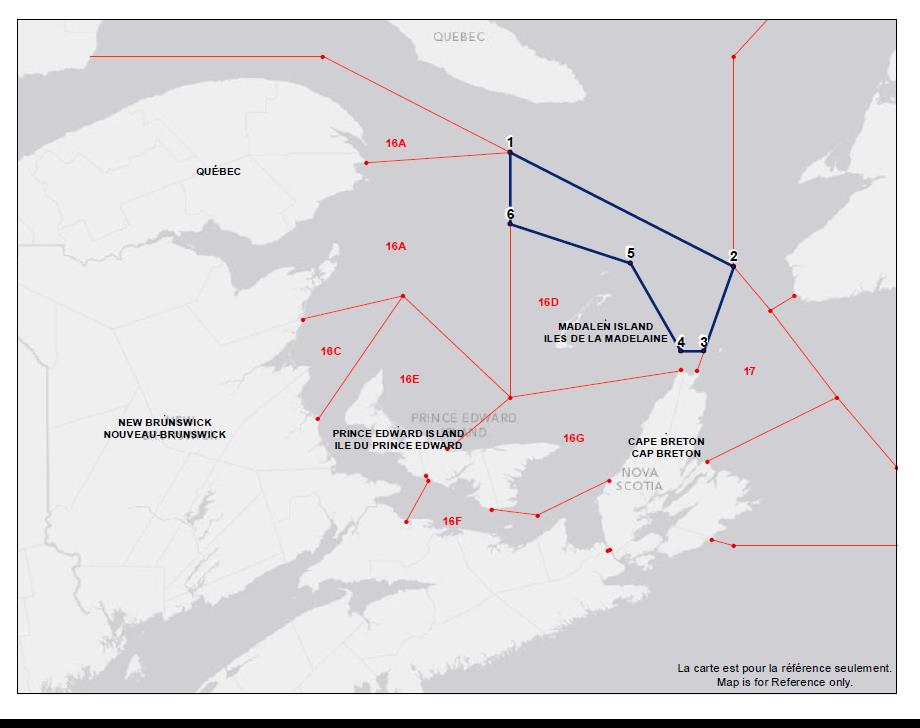
| Points | Latitude North | Longitude West |
| 1. | 48°42’00”N | 62°32’00”W |
| 2. | 47°50’00”N | 60°00’00”W |
| 3. | 47°11’06”N | 60°20’07”W |
| 4. | 47°11’06”N | 60°35’52”W |
| 5. | 47°51’33”N | 61°10’07”W |
| 6. | 48°09’33”N | 62°32’02”W |
| 1. | 48°42’00”N | 62°32’00”W |
Note: When the geographic boundary of an area is expressed in latitude and longitude, these point references are based on the geodesic system North American Datum 1927 (NAD27)
Description
The area where large purse seine fishery can occur (Edge) in May and June is defined as the waters enclosed rhumb lines (similar to straight lines plotted on a nautical chart) joining the following point s in the order they are listed:
Point 1 48°42’00’’ longitude North and 62°32’00’’ latitude West
Point 2 47°50’00’’ longitude North and 60°00’00’’ latitude West
Point 3 47°11’06’’ longitude North and 60°20’07’’ latitude West
Point 4 47°11’06’’ longitude North and 60°35’52’’ latitude West
Point 5 47°51’33’’ longitude North and 61°10’07’’ latitude West
Point 6 48°09’33’’ longitude North and 62°32’02’’ latitude West
Point 1 48°42’00’’ longitude North and 62°32’00’’ latitude West
Note: These reference points are based on the geodesic system North American Datum 1972 (NAD72)
Fisheries management order requiring all authorized fishing activities to be carried out without any at-sea observer on board fishing vessels
Due to the COVID-19 pandemic, The Minister of Fisheries and Oceans Canada has issued a Fisheries Management Order (FMO-2020-001), under section 9.1 of the Fisheries Act, which requires that all authorized fishing activities be carried out, on a temporary basis, without any at-sea observer coverage.
Under this Fisheries Management Order, the following requirements are imposed:
- All fishing activities authorized under the Fisheries Act must be carried out without any at-sea observer being onboard fishing vessels;
- Any person authorized to carry out fishing activities under the Fisheries Act is required to not authorize any at-sea observer to come on board any fishing vessel.
This Fisheries Management Order prevails over any regulations made under the Fisheries Act, any orders issued under those regulations, and over any conditions of any lease or licence issued under that Act.
This Fisheries Management Order takes effect on the day on which it was signed (April 2, 2020) and will remain in effect for a period of 45 days.
- Date modified: